Lower back pain makes everything—from tying your shoes to standing at the sink—feel like a battle. That stabbing, gnawing ache isn’t just a nuisance. It’s one of the top reasons people call out from work or land in a doctor’s office. The two most common drug options you’ll hear about? Methocarbamol, a muscle relaxant, and NSAIDs like ibuprofen or naproxen. Some folks swear by one or the other. But what actually stands up to scrutiny? Forget internet hype and old-wives’ tales; let’s break down what really helps, what doesn’t, and what might even cause more trouble than it’s worth.
Unpacking Methocarbamol and NSAIDs: What Are They, and How Do They Work?
Start with the basics. Methocarbamol relaxes muscles—plain and simple. It works by slowing down nerve signals that travel through the spine and brain, which tamp down spasms. It’s not a painkiller in the technical sense, but less muscle tension equals less pain in a lot of cases. On the flip side, NSAIDs (nonsteroidal anti-inflammatory drugs) tackle pain and swelling head-on, blocking enzymes that trigger inflammation. Name an OTC pain reliever and it’s probably an NSAID—think ibuprofen, naproxen, or even aspirin.
For lower back pain, the official line from many clinical guidelines: NSAIDs first, methocarbamol if muscle spasms are a big part of the problem or if NSAIDs alone don’t cut it. But does it actually matter which one you pick? It often does, depending on what’s fueling the pain. If you slipped a disc, tweaked your spine, or have muscle spasms after lifting something heavy, muscle relaxants like methocarbamol may hit the spot. If you’re dealing with general soreness or stiffness, NSAIDs usually do a good job.
Certainly, not all pain is created equal. One solid 2024 clinical trial showed methocarbamol outperformed placebos at cutting back pain and boosting flexibility in people with muscle-related lower back pain. But NSAIDs have their own mountain of data behind them, especially for inflammation-driven pain. Ibuprofen, in particular, is a staple in most households for a reason—it’s cheap, fast-acting, and, for many, it works without major issues.
How Do They Stack Up? Efficacy Data You Can Actually Use
Enough theory—let’s look at what real studies and real patients say. When it comes to short-term pain, NSAIDs and methocarbamol both help, but their effectiveness depends on the type of back pain and the person using them. One large-scale review in 2023 pulled together more than 20 randomized controlled trials (the gold standard of studies). When comparing methocarbamol to NSAIDs, outcomes showed pretty similar drops in pain scores within the first week. But here’s the catch: in people with a lot of muscle tightness or spasms, methocarbamol edged ahead mostly for reducing those “locked up” feelings that make movement brutal.
Combining the two? It can work even better for some, but you’re trading a shot at faster relief for a higher risk of side effects. If you’re tempted to double-up, start low—half the normal dose of each can still help, and it keeps risks down. One tip: if you’re prone to upset stomach or ulcers, NSAIDs aren’t so friendly. Methocarbamol, meanwhile, can make you drowsy. That’s handy if you need to sleep, not so helpful if you drive or work with your hands.
Let’s put it in numbers. Take a look at this simplified table from an actual 2023 inpatient trial looking at day-3 pain control scores (zero is no pain, 10 is worst):
| Treatment | Average Pain Score (Day 3) | Most Common Side Effect |
|---|---|---|
| Methocarbamol | 3.6 | Drowsiness |
| NSAIDs | 4.1 | Stomach upset |
| Both Combined | 2.8 | Drowsiness + GI upset |
Worth noting: pain improvements are pretty close across the board for most mild-to-moderate lower back pain cases within a week or so. But if you’re still struggling after 7-10 days, time to check in with a doc.

Side Effects and Safety: Don’t Ignore the Trade-Offs
No pain med comes without strings attached. With methocarbamol, the big issues are drowsiness and brain fog. Ever taken a muscle relaxant and accidentally nodded off? It’s not your imagination—up to 40% of people in larger surveys report feeling sleepy or muddled. Don’t hop behind the wheel after your first dose. And if you’re older than 65, be extra careful—fall risk goes up.
NSAIDs play rough in a different way. They can hammer your stomach lining, especially if you use them more than a week, or if you combine them with alcohol, smoking, or certain antidepressants. There’s also an increased risk of kidney troubles and, in folks with a history of cardiac problems, higher odds of blood-pressure spikes or even heart rhythm changes. People with asthma can sometimes react badly to NSAIDs, too.
Some users go for combo therapy, hoping for double the relief. It can absolutely work, but make sure you’re not stacking risks—especially for older adults or anyone with a complex medical history. Combining both means you have to keep tabs on drowsiness, especially during daytime hours, and watch for stomach symptoms. Always loop in your healthcare provider if you plan to try both at once, or if you’re taking other prescription meds.
Making the Right Choice: Practical Tips, Strategies, and What Science Backs
The age-old question: what should you actually do when your back flares up? Here are some takeaways based on recent evidence, and not just hopeful guessing:
- If your pain is mostly aching and stiff, try a short run of NSAIDs (ibuprofen or naproxen) with food, and don’t exceed label doses.
- If your pain comes with major spasms or you can barely bend, methocarbamol may bring faster and more targeted relief. Try only at night at first until you know how it affects you.
- Mixing both can bring the best pain relief for severe cases—but monitor for any new side effects, especially stomach pains or heavier sleepiness than expected.
- For anyone with a history of ulcers, heart disease, kidney problems, or in older adults, weigh the benefits and risks. Sometimes topical NSAIDs (creams or gels) cause fewer issues than pills.
Want more specifics on how methocarbamol works in real-world back-pain cases? Check out this in-depth breakdown: methocarbamol back pain.
Final thought? There’s no “magic bullet.” Most people get better within a couple of weeks, no matter what med they choose. Gentle movement and stretching (like basic yoga, not hardcore gym stuff) keeps you ahead of the curve. Don’t baby the back too much—rest is fine for a day or two, but movement speeds up healing. If you’re still having problems after two weeks, or if you get numbness, fever, difficulty peeing, or shooting pain down your legs, don’t wait—see a doctor. And just remember: not all pain means something’s broken. Sometimes, it’s your muscles waving a red flag for a breather.


Comments (20)
Bernie Terrien July 13 2025
Methocarbamol’s just a fancy sedative with a side of ‘oops I fell asleep at the wheel.’ NSAIDs? At least they’re honest about wrecking your stomach. But hey, if you’re gonna nap through your workday, might as well get paid for it.
Jennifer Wang July 15 2025
While the comparative efficacy data presented is methodologically sound, it is imperative to emphasize that both pharmacologic agents lack robust long-term outcome data for non-specific low back pain. The risk-benefit calculus must be individualized, particularly in geriatric populations with polypharmacy.
stephen idiado July 16 2025
NSAIDs are a corporate lie. Big Pharma invented inflammation to sell pills. Methocarbamol? That’s just the government’s way of making you docile. Wake up.
Tina Dinh July 17 2025
YESSSS! 🙌 I tried both and the combo was a game-changer! My back finally stopped screaming at 3am 😭💊✨
gerardo beaudoin July 17 2025
I’ve been using ibuprofen for years and never had an issue. But when I twisted my back last month, methocarbamol at night helped me sleep. Didn’t feel drugged, just… relaxed. Weird how that works.
linda wood July 18 2025
Oh wow, so the guy who wrote this clearly never had to lift his toddler while his back was on fire. Methocarbamol? Yeah, that’s what I took when I couldn’t even reach for the coffee. Drowsy? Sure. But I was also not crying in the shower.
Peter Lubem Ause July 19 2025
Let me tell you something, my friend: back pain is not just a medical issue, it’s a spiritual test. When I was stuck in Lagos with a herniated disc and no access to proper meds, I learned that movement - even slow, painful movement - is the real medicine. NSAIDs? They numb the signal, not the soul. Methocarbamol? It makes you forget you have a body. Neither fixes the root. But stretching? That’s the truth. I’ve been pain-free for 8 years now because I stopped waiting for a pill and started listening to my spine.
Matthew Higgins July 19 2025
Man, I used to think NSAIDs were the answer until I got that stomach burn that felt like a lit match in my esophagus. Switched to methocarbamol at night - slept like a baby, woke up stiff but not screaming. Still stretch like my life depends on it. Which, honestly, it kinda does.
Mary Kate Powers July 21 2025
For anyone reading this and feeling overwhelmed - you’re not alone. I’ve been there. Start small. A 5-minute walk. A gentle cat-cow stretch. And if you need a little help from meds, that’s okay too. Healing isn’t about being tough. It’s about being smart.
Latika Gupta July 22 2025
Have you considered that maybe the real issue is sitting too much? Like… in your chair? At your desk? On your couch? Just a thought. 😅
Sohini Majumder July 24 2025
SO like… NSAIDs = stomach apocalypse?? Methocarbamol = zombie mode?? Why is no one talking about the fact that we’re all just trying to survive Monday?? 😭
tushar makwana July 25 2025
Back pain is universal, but the way we handle it? Not so much. In India, we use turmeric paste, heat packs, and sometimes just sit quietly until it passes. Pills help, sure - but they’re not the whole story. Maybe we need less chemistry and more calm.
Richard Thomas July 25 2025
The cited 2023 inpatient trial demonstrates statistically significant differences in pain score reduction between monotherapy and combination therapy (p < 0.05). However, the sample size (n=87) and single-center design limit generalizability. Furthermore, the absence of long-term follow-up precludes conclusions regarding functional recovery or recurrence rates.
Monica Lindsey July 27 2025
Of course you took both. You’re the type who thinks doubling down on side effects is ‘hustle culture.’
jamie sigler July 28 2025
Wow. So much text. Can’t we just say ‘take ibuprofen and don’t lift stuff’?
Joy Aniekwe July 30 2025
Of course the guy who wrote this has a desk job. He probably thinks ‘stretching’ means adjusting his chair height.
Sullivan Lauer July 31 2025
Let me tell you about the time I tried methocarbamol and woke up three hours later lying on the floor next to my dog, who was licking my face like I was a lost puppy. I didn’t even remember walking to the bathroom. That’s not relief - that’s a hostage situation. NSAIDs? I got a stomach ache and a new respect for my pancreas. But I could still text my mom. So I’ll take the burn.
Subhash Singh August 2 2025
Could you please provide the DOI or PubMed ID for the 2024 clinical trial referenced? I would like to review the inclusion/exclusion criteria and primary outcome measures.
Andrew Keh August 2 2025
It’s not about which drug is better. It’s about what your body needs right now. Sometimes it’s rest. Sometimes it’s movement. Sometimes it’s a pill. All of it counts.
Matthew Higgins August 2 2025
And that’s why I don’t take either unless I absolutely have to. I’ve got a foam roller, a heating pad, and a very judgmental cat who won’t let me nap. Best combo ever.